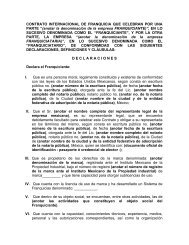mexico renews itself - ProMéxico
mexico renews itself - ProMéxico
mexico renews itself - ProMéxico
You also want an ePaper? Increase the reach of your titles
YUMPU automatically turns print PDFs into web optimized ePapers that Google loves.
24 Negocios ProMéxico Negocios ProMéxico 25<br />
Mexico’s renewable energy<br />
industry has grown in leaps<br />
and bounds over the last few<br />
years, due to a combination<br />
of government incentive<br />
programs and an influx of<br />
foreign capital.<br />
photo archive<br />
“The heftiest cost in a wind project is the turbine and few are<br />
made in Mexico. They are generally imported. We’ve received<br />
equipment from Denmark, Spain and the US.” This, says Rodríguez<br />
Olivé, opens up investment opportunities for equipment<br />
developers and manufacturers for the wind industry.<br />
The challenge, he says, is twofold: “to improve transmission<br />
infrastructure, so the grid reaches places where the wind is strong<br />
enough to generate electricity, and promote the development<br />
and growth of small-scale producers so more generation projects<br />
spring up around the country.”<br />
A Bright Business<br />
The solar energy industry in Mexico has “a positive outlook in<br />
terms of the development of a market on which natural, environmental<br />
and other factors have come together with increased<br />
supply, resulting in more accessible prices,” says Alberto Valdés,<br />
president of the National Committee for Energy Regulation and<br />
deputy editor for the National Solar Energy Association (ANES).<br />
Solar water heating systems designed for residential and commercial<br />
use are one niche that has grown considerably. This<br />
expansion can partly be attributed to “financial mechanisms for<br />
residential developments that provide for solar thermal energy<br />
systems, like the Green Mortgage program implemented by the<br />
National Workers’ Housing Fund Institute (INFONAVIT),” which<br />
has already equipped around 120,000 homes with solar water<br />
heaters. Now all homes mortgaged via INFONAVIT are required<br />
to have solar water heaters and comply with related regulations.<br />
Aside from federal programs, several states have introduced initiatives<br />
to promote the use of solar energy. The Mexico City government<br />
“has issued environmental regulations requiring all businesses<br />
that provide hot water, such as restaurants and gyms, to heat at least<br />
30% of their supplies using solar energy,” says Valdés. As a result, the<br />
number of industries participating in the sector –from manufacturers<br />
to distributors of solar water heating systems– has grown.<br />
Installed capacity is an excellent way to measure the extent<br />
to which the industry has expanded. According to Valdés, there<br />
are now 1.66 million square meters of solar water heaters installed<br />
in Mexico compared to between 250,000 and 300,000<br />
square meters 10 years ago. “We are excited about the future.<br />
The goal of the National Solar Water Heater Program implemented<br />
by the Ministry of Economy (SE) and the National<br />
Commission for Efficient Energy Use (CONAE) is to close 2013<br />
with 2.5 million square meters, while the target for 2020 is 23.5<br />
million square meters.”<br />
The other important niche is “interaction with the government,<br />
which covers alternative methods of capturing solar<br />
energy, like photovoltaic and wind energy systems, both of<br />
which can be hooked up to the electricity grid,” says Valdés,<br />
who is quick to point out that, under Mexican law, electricity<br />
cannot be generated by private entities for sale to other private<br />
entities. “What the law allows you to do is generate your own<br />
electricity and transmit it to the grid in exchange for what you<br />
consume.”<br />
Mexico has 510,000 high energy domestic users, but if they<br />
“simply purchased a photovoltaic system to avoid using electricity<br />
during peak hours, they could save money on their electricity<br />
bills,” says Valdés.<br />
But there are still other niches to explore, like solar-powered<br />
transport systems covering short, local routes of 10 to 15 kilometers,<br />
says Valdés, adding that “large generators connected<br />
to the grid are another area of opportunity, because the price<br />
of photovoltaic electricity is dropping […] we now have a commercial<br />
tariff of 1.30 to 1.40 usd per watt, while rates for thermoelectric<br />
generators are in the region of 1 usd per watt. This<br />
means we are very close to matching conventional rates.”<br />
Nature’s Boons<br />
AMDEE president Leopoldo Rodríguez Olivé believes Mexico<br />
has several competitive advantages in the wind energy industry.<br />
“Aside from regulatory incentives, we have something few other<br />
countries have: places with winds so strong they can generate<br />
from 30% to 100% more electricity than other parts of the<br />
world. This increased generating power compensates for subsidies<br />
and makes Mexico more attractive to investors.”<br />
Furthermore, the country’s “legal and regulatory framework<br />
is considered solid and there are good financing options.”<br />
From the standpoint of the solar energy industry, Alberto<br />
Valdés says that Mexico’s geographical location constitutes its<br />
greatest advantage in terms of solar radiation. In the Northwest<br />
alone, solar radiation can exceed 6 kWh per square meter a day,<br />
while the rest of the country receives an average of 4.5 to 6 kWh.<br />
Other factors that have facilitated the development of the<br />
industry in Mexico include “legislation for the installation of<br />
solar water heating systems, and the possibility of hooking up<br />
to the electricity grid,” says Valdés.<br />
Plus, “we have a Regulatory and Evaluation Committee to<br />
ensure all solar heating systems sold here comply with international<br />
standards.”<br />
Backed by a solid legal framework and government programs,<br />
it seems Mexico’s renewable energy industry is well positioned<br />
to harness the inexhaustible forces of nature and can<br />
look forward to a bright and breezy future. n

















